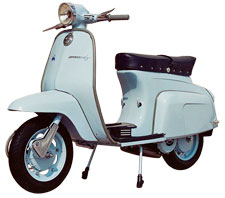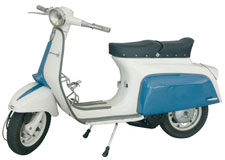Lambretta Model 125 Junior and Cento



Cento SpecificationsYears produced: 1964 - 1965 (Cento) Amount produced: 17,642 Engine: 1 cylinder, air cooled 2-stroke Induction: piston ported Bore: 51 mm Stroke: 48 mm Cubic capacity: 98 cc Compression ratio: 7.5:1 BHP at rpm: 4.7 @ 5300 Transmission: 3 speed constant mesh Lubrication: 2% Carburetor: Dellorto SHB 18/16 Ignition: contact breaker & points Ignition timing: 24 degrees BTDC Breaker gap: 0.35-0.45 mm Voltage: 6 volt Wheel size: 10" Tire size: 3 x 10 Max speed: 46 mph Total dry weight: 176 lbs |
J125 SpecificationsYears produced: 1964 - 1966 (J125)Amount produced: 21,651 Engine: 1 cylinder, air cooled 2-stroke Induction: piston ported Bore: 57 mm Stroke: 48 mm Cubic capacity: 122 cc Compression ratio: 7.4:1 BHP at rpm: 5.8 @ 5300 Transmission: 3 speed constant mesh Lubrication: 2% Carburetor: Dellorto SHB 18/16 Ignition: contact breaker & points Ignition timing: 24 degrees BTDC Breaker gap: 0.35-0.45 mm Voltage: 6 volt Wheel size: 10" Tire size: 3 x 10 Max speed: 42 mph Total dry weight: 198 lbs |
J125 SpecificationsYears produced: 1966 - 1969 (J125)Amount produced: 16,052 Engine: 1 cylinder, air cooled 2-stroke Induction: piston ported Bore: 57 mm Stroke: 58 mm Cubic capacity: 122 cc Compression ratio: 7.4:1 BHP at rpm: 5.8 @ 5300 Transmission: 4 speed constant mesh Lubrication: 2% Carburetor: Dellorto SHB 18/16 Ignition: contact breaker & points Ignition timing: 24 degrees BTDC Breaker gap: 0.35-0.45 mm Voltage: 6 volt Wheel size: 10" Tire size: 3 x 10 Max speed: 55 mph Total dry weight: 198 lbs |
LAMBRETTA MODEL 125 JUNIOR AND CENTO HISTORY
To respond to the market demand for a simpler scooter with a cheaper price tag. Innocenti presented a completely new model of Lambretta in the spring of 1963 that would become the first in a series of economic scooters called "Junior".
For its conception, the design center at Innocenti was inspired by its competition at Piaggio. In fact, the whole frame of the scooter was conceptually very similar to that of the Vespa. The motor, on the other hand, was based on the LI, except that the cylinder was vertical rather than horizontal.
For the first time in Innocenti history, a new model would be released with the unusual 98cc engine. Market research had revealed that this sized motor would be the right path to follow since it would satisfy different markets. Innocenti was soon proved wrong, and to attempt to fix the situation, soon offered a 125cc version as well. At first, the Cento was sold almost exclusively in foreign markets.
Later, perhaps because of a waning interest abroad, the scooter was sold also in Italy at the low price of 119,500 Italian lira.
The lines of the bodywork were based on the tried-and-true LI Series III, but at the same time some important differences separated the two models. The front horn cover of the LI was totally eliminated; the opening to the glovebox was moved under the seat; and the side panels were smaller compared to the size of the scooter.
The seats on the very first examples of the Cento put out by Innocenti were quadrangular but would soon be replaced by long, dual-passenger bench seats. To save on production costs for this model, Innocenti offered the scooter in the only one color, light ivory.
As started earlier, the motor derived from the LI but was further simplified. The primary transmission was a simplex chain and the gear ratio was reduced. The modest 4.7 horsepower engine limited the performance of the Cento, so it could not even reach 80 km/h. The shoddy quality of the motor and the extremely fragile frame foreshadowed the premature end of the Cento in 1965 after only 17,642 units had been produced.
To try and bounce back from unexpected commercial failure of the Cento, Innocenti presented a larger 125cc version in September 1964 with much improved performance both in the robust nature of the engine and its maximum speed of 80 km/h. The resilience of the motor was shown in the advertising campaign since the scooter was nicknamed Superelastic (Super resilient). Esthetically, the new 125 remained exactly the same as the little sister, expect that a metallic gray color was offered.
To avoid the frame breaking, which happened all too often, the main internal tube was reinforced, but this did not solve this grave defect once and for all. A final solution would not see the light of day until 1966, when the frame would be entirely redesigned based on two years of research.
The Lambretta 125 Junior stayed on the assembly line for two years but was never able to reach the production levels that the successful LI had reached. Looking at the production figures suggests that 32 units of the LI were produced hourly compared to only 17 of the Junior.
At the beginning of the summer of 1966, Innocenti debuted a new version of the 125 Junior with more aerodynamic and slick bodywork. The front legshield was smoother and therefore offered less wind resistance, while the rear was shaped to be more in uniform with the long seat. A small, chrome star was attached to the legshield with 125 written on it, which was the origin of the curious nickname Stellina, or "little star".
The performance of the engine was further improved. An extra gear was added allowing the Stellina to reach 87 km/h with ease.
As usual, the introduction of a new model called for a new paint scheme. The most common was the two-tone white and "ocean blue", but other colors were available mostly to satisfy the different tastes of the foreign market. With the resolved structural problems of the frame and a more powerful engine, the Lambretta 125 J seemed sure to succeed, but once again was unable to catch the heart of the public. The overall disinterest in motorcycles and a selling price which was too near that of the larger model (the LI), probably added to this unsuccessful but nevertheless attractive scooter. In about three years of construction, only a few more than 16,000 were built.
To satisfy the specific requests of the English market, a small series of four-speed Lambretta Js were produced with a turning front fender and a small horn cover on the center of the legshield. This model was dubbed the "Super Starstream" while the normal version was simply called the "Starstream". Both versions were available in an elegant two-tone.
